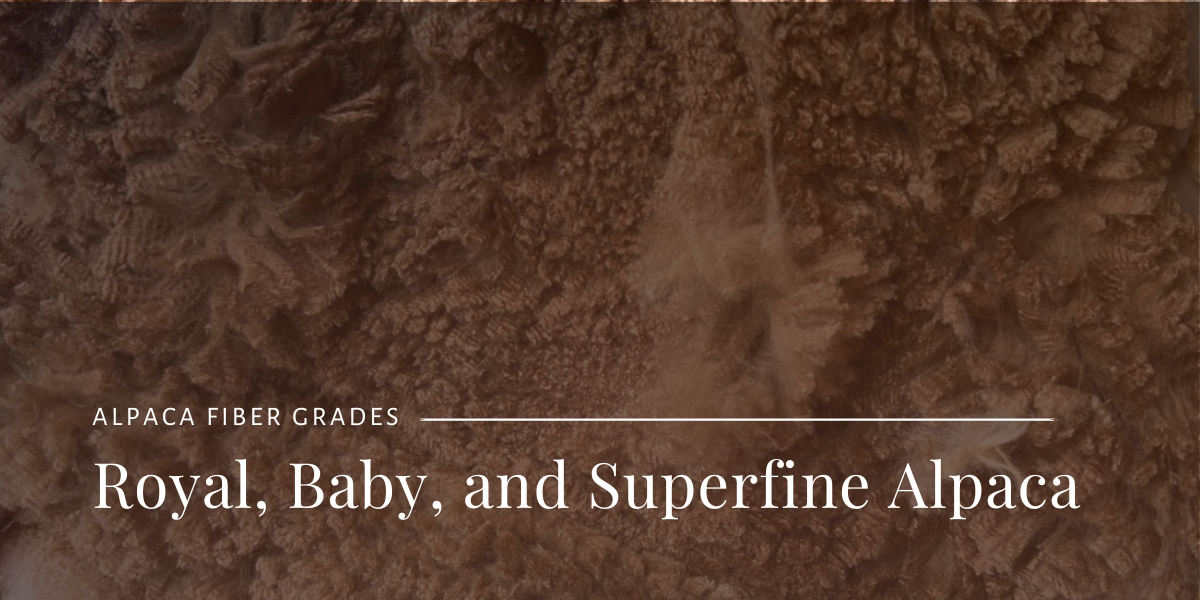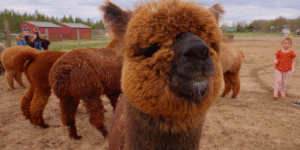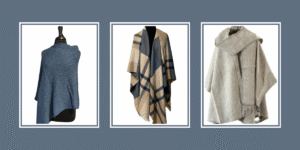If you’ve ever shopped for alpaca products you may have encountered terms like royal alpaca, baby alpaca, or superfine alpaca. As a buyer, these terms can be really confusing. What makes this even worse is the fact that these terms vary by country and each country can have its own set commercial terms and metrics to qualify what quality of fiber falls into each classification.
Why is this so darn confusing? There is no international regulation for alpaca fiber grades and the assignment is left to each individual country and their industry associations.
As I researched this topic, I was pretty frustrated, so I can only imagine what consumers must feel as they shop and compare one product to another. I’ve been raising alpacas for years, we make our own alpaca products, I can feel the difference between grades, and yet I still felt overwhelmed by the limited and conflicting information available for buyers of alpaca products.
Today I’d like to do my best to sort through this topic and explain the difference between the common commercial terms of royal alpaca, baby alpaca, and superfine alpaca. We’ll also cover how alpaca finer is tested, when it is tested, and why these terms matter.
Alpaca Fiber Testing With OFDA
The alpaca industry uses OFDA (Optical Fibre Diameter Analyser) testing equipment to evaluate our fiber. Originally developed in Australia, the equipment was designed to provide a fast, precise, and reliable testing process for evaluating wool samples.
There are three versions of OFDA testing equipment in practice:
- OFDA100 – This testing equipment was introduced in the 1990’s and is no longer in production. That said, it is still used today to test and report fiber characteristics for the Alpaca Owners Association.
- OFDA2000 – This newer testing was made available in 2000. It is similar to the OFDA100, more advanced, but the testing is not an exact match to its predecessor.
- OFDA4000 – The most current version of testing has been available since 2002. This machine uses an optical vision system to directly scan fibers and measure fiber characteristics.
So, while the usage of commercial terminology is not consistent, the measurement of fibers is very uniform across our industry. The alpaca industry worldwide will use the ODFA equipment line to electronically measure the characteristics of alpaca finer.
Alpaca Fiber Testing Throughout the Supply Chain
I love data and the alpaca industry’s usage of data is spot on. We test our fiber throughout the supply chain, which provides quantitative data to what could be very subjective analysis.
Each year after shearing our farm will test our fiber to measure its quality and what goods it can produce. We also use this data for determining breeding potential of our alpaca herd.
When testing alpaca fiber our farm will use the following measurement options:
- Histogram testing results via ODFA equipment – By default, we test every new alpaca baby we have so we can understand their baseline fiber quality and the quality of offspring they can produce. These results will also be used for determining fiber usage. For this we use SGS Fiber Testing Lab if we are participating in the AOA’s EPD program or Alpaca Consulting Services USA if using internally. These testing services use the OFDA100 and OFDA2000 respectively.
- Professional fiber sort and analysis with a trained professional – If we are going to pool of fiber into a large batch for commercial production, we’ll have a professional sort done to visually review and sort all fiber blankets into different grades (explained later). This is done on our farm and it will include any fiber we’ve collected from other farms.
- Post production product testing – But testing doesn’t just stop there. Once goods are processed into yarn, we can have this sent out for testing too. Our last batch of socks had an independent lab (Vartest Laboratories) test the finished yarn to validate the wool composition and the micron count (softness). In this example, the testing validated our sock yarn was 51.5% alpaca (24.4 microns) and 48.5% merino (21.8 microns). This is an extra level of protection for us and our product buyers, because it independently validates what is in our socks and that online buyers are receiving what they believe they are ordering.
When we source finished goods from our Peruvian partner, we are confident in their quality as well. They have multigenerational sorters who sort and grade the incoming raw fiber and then they retest the fiber and yarn as it makes it way through their manufacturing process. When we toured the manufacturing facilities last October it was really cool to see the sorters and ODFA4000 in action.
USA Commercial Terms for Alpaca Fiber
Once the alpaca fiber testing is done, we have the measurement of our micron count, which translates into fiber grades. These grades then will transfer into the commercial terms of royal, baby, or superfine alpaca.
When evaluating natural fibers, it is important to remember the lower the micron count, the softer the fiber. But that softness comes with a tradeoff of manufacturability and durability.
Let’s look at the most common commercial terms for alpaca products in the USA:
- Royal alpaca – Royal alpaca the one of the softest grades of alpaca fiber, so it is buttery soft to the touch. It feels amazing on your skin, but that softness makes it more difficult to use in industrial knitting machines and it can create a floppy product that is more easily stretched. Royal alpaca works well for throws, shawls, and sweaters.
- Baby alpaca – Baby alpaca has a slightly higher micron count than royal, but it is still super soft. It is easier to knit with and it won’t be as floppy or forgiving as royal alpaca. We use baby alpaca for lots of products from blankets and ponchos to hats and scarves.
- Superfine alpaca – Superfine alpaca is less soft than baby, but still an excellent product that is super versatile because it is more robust and it provides better memory. It works great for machine knitting socks, hats, gloves, and anything that needs a more durable wear.
In the U.S. our fiber classifications fall into the following buckets. It is very common to see the usage of baby alpaca, while not as common to see royal and superfine. And sadly, many products won’t list anything at all.
When we first started our farm and started to make hand-knit products I wanted royal alpaca for everything. Then I realized this wasn’t as versatile, and in some products, it wasn’t the best usage of the material. My husband and I soon realized baby alpaca was a better option, and superfine alpaca was amazing.
USA vs. International Grading of Alpaca Fiber
As we move into the actual micron count results of the alpaca fiber and compare this to the commercial terminology used, we quickly see a lot of diversity. The American fiber grading does not translate to the same usage and verbiage in other countries. While similar, there are many differences.
This can be very challenging for textile brands who buy raw fiber and consumers who purchased end use products. The only way to truly compare alpaca fiber and products across countries is to skip past the use of “grades” or the commercial terms and look solely at micron count. Micron count is the only datapoint that spans across the international markets.
USA Alpaca Fiber Grades
Australia Alpaca Fiber Grades
Canada Alpaca Fiber Grades
Peru Alpaca Fiber Grades
Note: If you shop in the tourist areas of Peru you’ll be told everything is baby alpaca. Trust me it is not and this drove me crazy during our visit to Peru. I know the products and I could feel it was not baby alpaca in at least 50% of the products I looked at. However, when we have something made at our trusted partners in Peru, they are testing throughout their process, so when they say something is baby alpaca I 100% believe them. They are very thorough and their manufacturing process is highly regulated (we saw it first hand), so I have very high confidence in these products.
New Zealand Alpaca Fiber Grades
The Takeaways
I’ve written blog posts about knowing what alpaca products you’re buying and who your buying those products from. Looking at the use of commercial terminology of alpaca products just amplifies this need.
Regardless of country, there are reputable sellers and there are who are less than honest. This is becoming more and more evident as the popularity of alpaca products grows. And we’re seeing this become very apparent in alpaca sock marketing where companies hide the fact that products are being made in China and imported.
As an alpaca breeder and product producer I find this very frustrating. My only recourse is to do research and provide education to those who wish to review it.
References:
- https://www.alpacainfo.com/academy/article/4662/u.s.-alpaca-fiber-standard
- https://www.alpacainfo.ca/downloads/codeofpracticeupdatemarch06.pdf
- https://alpacafibre.com.au/fibre/index.php/fleece/
- https://pacificalpacas.com/wp-content/uploads/2021/11/Fine-Fibre-Guidelines.pdf
- https://aia.org.pe/wp-content/uploads/2020/04/ALPACA-ORIGIN-MARK-REGULATION.pdf
- https://aia.org.pe/la-alpaca/#propiedades-y-cualidades




